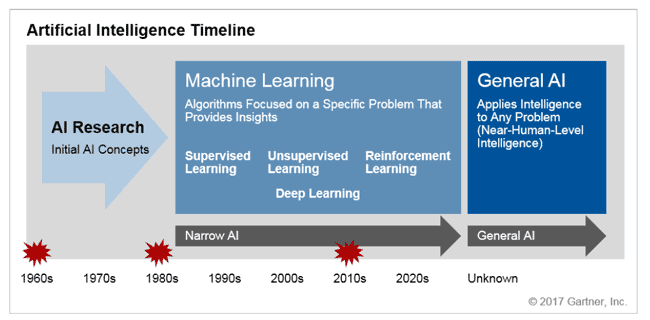Spend management and applications have been gaining in popularity for some two decades.
However, says Gartner analyst Patrick Connaughton, in a predictions relative to procurement technology for 2018, big changes are coming in this area.
Supply Chain Digest Says... |
 |
| New entrants into the spend analysis software space will quickly leapfrog traditional providers by embedding off-the-shelf, Cloud-based BI tools with built-in AI capabilities. . |
 |
What do you say? |
| Click here to send us your comments |
 |
| Click here to see reader feedback |
|
|
"The procurement and sourcing technology landscape has a long way to go to reach maturity," Garter says. "However, some areas, like spend analysis, will not have a chance to reach maturity before advancements in areas like artificial intelligence (AI) will render traditional tools obsolete."
In fact, Garter predicts that by 2022, 50% of all legacy spend analysis software will be retired; replaced by AI-powered, Cloud-based solutions.
While there has been a lot of favorable press relative to the results from spend analytics in recent years, Gartner says that for many strategic sourcing teams, legacy spend analysis software has failed to deliver on its promise.
To be clear, Gartner says "legacy" systems are characterized by:
• Generally being installed on-premise (versus Cloud)
• The requirement to define a rigid spend taxonomy
• Utilization of a combination of auto-classification rules and extensive manual effort to "enrich" the data before category managers have a basic starting point for analysis
Use of such legacy systems, Connaughton says, are time-consuming and error-prone, with users often unable to quickly respond to changing market conditions and make rapid decisions.
In addition, Connaughton says these legacy systems are also characterized by what Gartner calls "narrow AI."
What's that? Narrow AI consists of highly scoped machine-learning solutions that target a specific task, such as classifying spend. The algorithms chosen are optimized for that task. As a result, these solutions are limited, Connaughton says, since they are designed to answer a predefined set of questions.
Therefore, "They cannot unearth insights the end user didn't know he or she should explore," Connaughton says.
"The next generation of tools will build on this foundation with general AI." Connaughton adds. "This refers to the use of machine learning to handle a broad range of use cases. These systems will be able to successfully perform any intellectual task that a human could perform and would learn dynamically, much as humans do.
The software robots are really here, it would seem. This progression is seen in the graphic from Gartner below.

These of course are general software developments, and hardly relevant to procurement applications alone. In fact, Gartner predicts that by 2020, natural-language generation and AI will be standard features of 90% of modern business intelligence (BI) platforms.
(See More Below)
|
CATEGORY SPONSOR: SOFTEON |
|
|
| |
|
|
Natural-language processing combined with machine learning will then dynamically and automatically identify the most relevant insights and context in data (trends, relationships, correlation patterns), in a major leap forward in spend analytics.
The implications for spend analysis are significant, Gartner says.
"Rather than requiring predefined spend classification algorithms, taxonomies and manual enrichment, natural-language processing can automatically find, visualize and narrate important findings," Connaughton says, adding "Put another way, the solution will be able to not only classify the data but also interpret it to draw out trends and recommend actions."
This, he says, is essentially the first step toward creating a virtual category manager.
The result, Connaughton alsos not, will be that new entrants into the spend analysis software space will quickly leapfrog traditional providers by embedding off-the-shelf, Cloud-based BI tools with built-in AI capabilities.
"These providers will set their sights on providing holistic procurement analytics solutions spanning spend analytics, embedded operational metrics (e.g., savings, cycle times), predictive forecasts and aggregated market intelligence - a one-stop shop for category managers' analytics needs," Connaughton predicts.
All that means it is time for chief procurement officers to determine which tools for spend analysis are being used in the company today, and then evaluating whether these existing solution providers are keeping pace with market advancement in BI visualization and AI natural-language processing for spend classification.
It will also be important, Connaughton concludes, to compare the visualization and AI capabilities between dedicated spend analysis tools as well as general-purpose BI solutions.
It's a brave new supply chain technology world for sure.
What is your take on Gartner's predictions for spend analytics? Will AI take over the procurement world? Let us know your thoughts at the Feedback section below.
Your Comments/Feedback
|